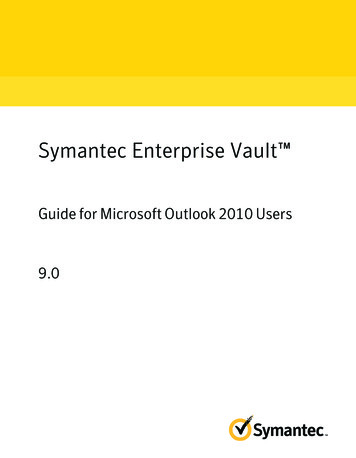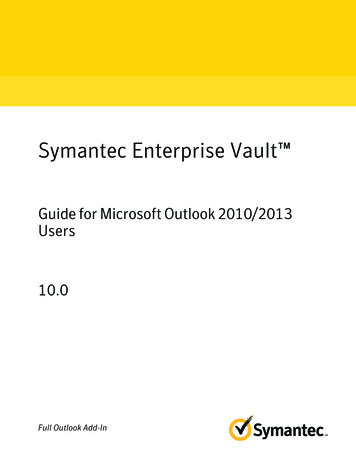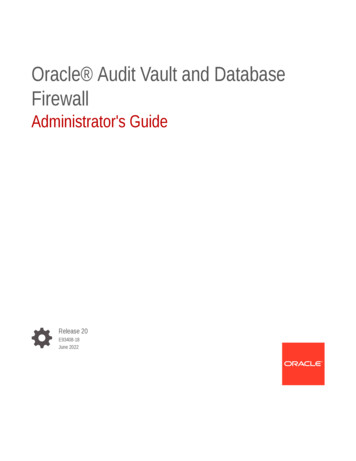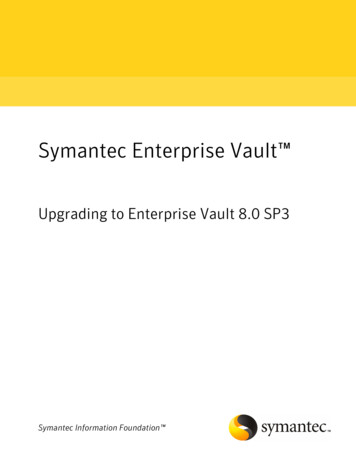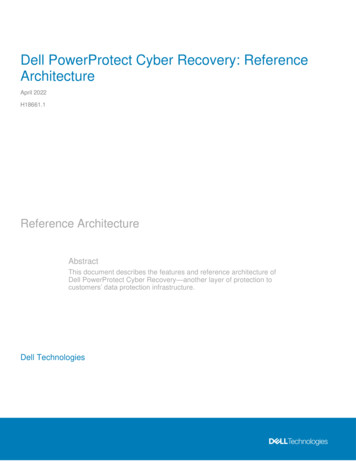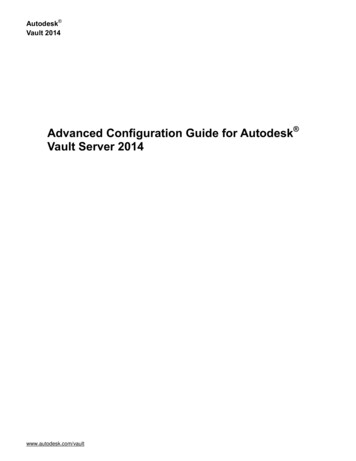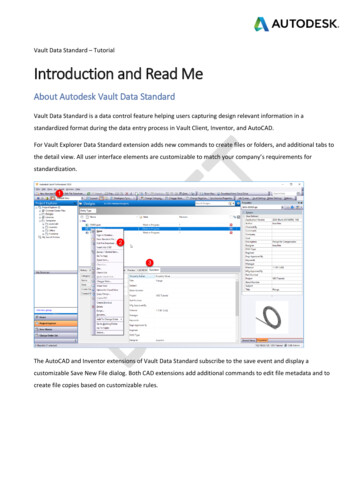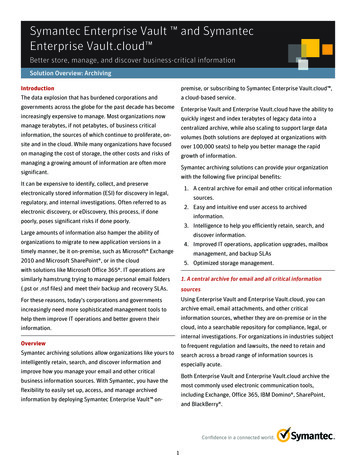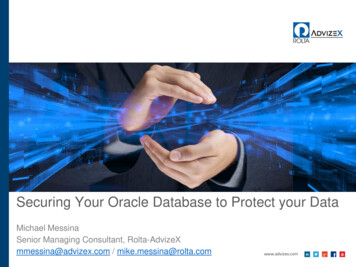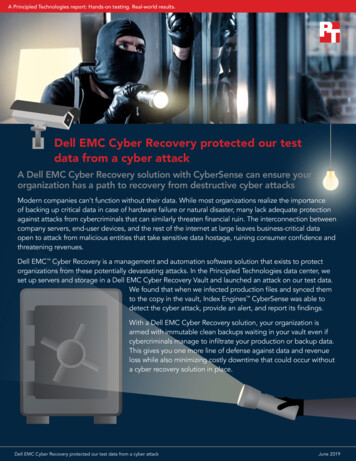
Transcription
A Principled Technologies report: Hands-on testing. Real-world results.Dell EMC Cyber Recovery protected our testdata from a cyber attackA Dell EMC Cyber Recovery solution with CyberSense can ensure yourorganization has a path to recovery from destructive cyber attacksModern companies can’t function without their data. While most organizations realize the importanceof backing up critical data in case of hardware failure or natural disaster, many lack adequate protectionagainst attacks from cybercriminals that can similarly threaten financial ruin. The interconnection betweencompany servers, end-user devices, and the rest of the internet at large leaves business-critical dataopen to attack from malicious entities that take sensitive data hostage, ruining consumer confidence andthreatening revenues.Dell EMC Cyber Recovery is a management and automation software solution that exists to protectorganizations from these potentially devastating attacks. In the Principled Technologies data center, weset up servers and storage in a Dell EMC Cyber Recovery Vault and launched an attack on our test data.We found that when we infected production files and synced themto the copy in the vault, Index Engines CyberSense was able todetect the cyber attack, provide an alert, and report its findings.With a Dell EMC Cyber Recovery solution, your organization isarmed with immutable clean backups waiting in your vault even ifcybercriminals manage to infiltrate your production or backup data.This gives you one more line of defense against data and revenueloss while also minimizing costly downtime that could occur withouta cyber recovery solution in place.Dell EMC Cyber Recovery protected our test data from a cyber attackJune 2019
What is Cyber Recovery?Don’t confuse cyber recovery with disaster recovery (DR)—they protect data in different ways, fromdifferent kinds of threats. Disaster recovery involves planning for events that render an organization’sprimary data center unusable, such as flooding or power grid failure. DR plans involve keeping backupsof all data and services in a separate location that’s far away enough to avoid the primary site disaster, but closeenough to quickly replicate backups, either in a company-owned DR site or in the cloud.The Dell EMC Cyber Recovery Vault protects critical infrastructure and data with an isolated, immutable copy ofdata for critical applications, which is protected from cybercriminals that infiltrate an organization and destroy orhold hostage its data. An organization that loses access to and control of their sensitive data may find it difficultor impossible to continue with their mission for multiple reasons, and paying an exorbitant ransom may be theonly way to regain access. Day-to-day operations may cease as their infrastructure grinds to a halt, costing untoldrevenue loss.Cyber recovery solutions exist to enhance an organization by making backup copies more resilient, allowingrecovery after more sophisticated attacks.How do attackers get in?If there’s a way in, cybercriminals can find it. That’s why a comprehensive, proactive cyber recovery plan is anorganization’s best defense against both external and internal threats. Here are some common methods of attacksthat criminals use:Taking control of your backup serverCybercriminals know that you have a DR plan in place that involves keeping backups, so it’s not enough to targetyour production environment. By targeting your backup servers, criminals take away your ability to recover byensuring you don’t have a place to start over if they attack your production environment.Destroying or encrypting your data protection storageEnlisting data protection storage using Dell EMC Data Domain can enable you to restore reliably and to completebackups faster via inline deduplication of data, but it also provides another point of attack for criminals. In thesetypes of attacks, the criminal may gain access to your backup environment by stealing credentials or employingtactics, which could result in the loss of your data protection storage. Or, they may encrypt your backup data—which means it’s no longer of use to you unless you have the encryption key.Compromising the management network for storage and serversCybercriminals can also attack the management network for your infrastructure, and even if your backups areprotected by data governance, cybercriminals can use a low-level attack destroying the storage RAID group. Byluring unsuspecting end-users connected to your network with phony links and downloads, attackers plant malwareor ransomware that gives them control of data unless you pay to give it back.Insider attackIt’s not just an urban legend —sometimes the criminal is already inside the house. Disgruntled employees can mapout an entire organization and gain access to critical systems credentials, or attach small devices to the network thatseek out critical information to later gain access to the system. Once they obtain the right information, it’s only amatter of time before a serious attack can happen.Dell EMC Cyber Recovery protected our test data from a cyber attackJune 2019 2
Levels of data protectionAs threats continue to emerge, so do protection options for your critical data. Below, we outline a good-better-bestapproach that lets you review your current data protection strategy and find ways to improve.GoodSite BData backups: Backing up data to another locationoffsite or in the cloud.Disaster recovery plan: A DR plan is the documentedprocess you have in place that directs your team howto recover in the event of a disaster. DR plans includea recovery time objective (RTO), which is a time targetfor restoring business processes, and a recovery pointobjective (RPO), which is the age of the files/data youwill start from after a disaster.Site ASite AWarm or hot replication sites for DR: Replicating datato warm or hot sites reduces your business downtime.Warm site failover should be ready to restore businessprocess with hours of downtime; hot site failover is forzero-downtime targets for the most critical data.BetterEncryption at rest: Data protection that makes stored(or at-rest) data unreadable to unauthorized users.Users must have an encryption key to access this data.Retention lock: Dell EMC Data Domain Retention Locksoftware offers immutable file locking and flexibleretention policies.Site BProduct-hardening best practices: Reduce the surfaceof vulnerability by reducing the number of functions asystem performs.Dell EMC Cyber Recovery protected our test data from a cyber attackJune 2019 3
BestCyber recovery solution: Provides a physically- and network-isolated copy of data that protects against ransomware,insider attacks, and more.Professional services: Professional services can help you assess your organization’s needs and advise on the best planto keep your data safe.Security analytics: In the event something does go wrong, analytics looks for indicators of compromised data and canhelp you discover the who, how, and the why, so you can recover quickly from attack.Site ASite BCyber Recovery SolutionDell EMC Cyber Recovery protected our test data from a cyber attackJune 2019 4
How the Dell EMC Cyber Recovery Vault works to help you recoverfrom attacksDell EMC Cyber Recovery is a complete, isolated recovery solution that helps you minimize downtime, expense, andlost revenue by providing a resilient backup to critical data and a path to recovery from a cyber attack. To start, DellEMC offers professional services that help you assess, plan, implement, and validate your cyber recovery solution.Production environments are vulnerable to attack. Dell EMC Cyber Recovery keeps your data in a vault, where it isphysically and logically isolated from other systems and locations. Physically, the Cyber Recovery Vault resides in arestricted room or area in your facility accessible only by authorized physical access, which limits the ability of in-housesaboteurs and those that wish to hold your data for ransom to complete their objectives.Logically, Dell EMC Cyber Recovery disables the replication NIC, effectively creating an air gap between the productionnetwork and the Cyber Recovery Vault to ensure that the data inside is isolated from other networks. Command andcontrol of the vault comes from within Dell EMC Cyber Recovery software. The software orchestrates connecting thenetwork interface to the production Data Domain appliance, replicating the data into the vault, and disabling the networkinterface to secure the vault when replication is complete. Data Domain replicator software can encrypt data in flight forfurther security. The CR Vault is not vulnerable during replication, offering no access to the management plane.DD replicationBackup app hostsProduction appsRecovery test hostsBackup SWDell EMC Data DomainAir gapManagement hostsDell EMC Data DomainThe image below shows how Dell EMC Cyber Recovery and CyberSense work to protect, analyze, and secure yourcritical Index &analyzeCyberSenseDell EMC Cyber Recovery protected our test data from a cyber attackJune 2019 5
Breaking into the vault: Our hands-on testsDoes a Dell EMC Cyber Recovery solution work? When we set up our own infrastructure andtested it out, we found that we were able to successfully set up the solution and that Dell EMCCyber Recovery offered protection against the simulated cyber attack we introduced.In the PT data center, to simulate an enterprise solution with real applications running, we installed and configureda four-node Dell EMC VxRail V470F cluster, deploying Microsoft SQL Server , clients, and infrastructure VMs. Weracked and configured two Data Domain appliances, deployed Networker, and set up backup policies so that theSQL Server databases would back up to a storage pool managed by the first Data Domain appliance.In this testbed, we deployed Cyber Recovery and set up replication between both Data Domains; the first we usedas our production backup appliance, and the second we used as the Cyber Recovery Vault storage. We createda new Cyber Recovery policy to synchronize between the Data Domains, and initialized a copy from productionto the Vault. We were able to verify that during synchronization between the production and vault environments,only the replication port—which is data only and provides no management capabilities—was accessible from theproduction environment. When the sync ended, the replication port once again became inaccessible becausethe interface was disabled. The CR solution also offers the ability for the CR administrator to manually secure thevault, and no new data can replicate into the vault until the admin removes the secure lock. Our team also tested arecovery scenario from the vault by creating a duplicate copy of the target data inside the vault, and then exportingthat duplicate copy to an application server outside the vault environment. We found that the recovery processworked as intended, and could offer a predictable recovery experience should an organization need to start freshfrom their locked down backup.Dell EMC Cyber Recovery with CyberSense analytics detected an attackFirst, we deployed Index Engines software on a Linux host, added it as an Application Asset in Cyber Recovery, andsynced and created a clean backup copy from our production server to our storage in the vault. We ran an Analyzejob using CyberSense and found no evidence of attack.When we added files infected with malware to the production server and replicated this data to the vault,CyberSense correctly ascertained that an attack had taken place and raised an alert to CR when it detected thesuspicious copy.ConclusionFailing to consider the possibility of malicious actors controlling or holding hostage your organization’s data is apotentially expensive gamble. While planning for natural disaster or hardware failure with a DR plan is the firststep to keeping your data safe, your critical data is still vulnerable without acomprehensive recovery plan that guards against cyber attacks. In our labs, wefound that Dell EMC Cyber Recovery offered an isolated recovery solution thatprovides an isolated, immutable copy of critical data, and enables analysis of thatdata so organizations can quickly recover critical infrastructure and data assets.Read the science behind this report at http://facts.pt/a2jur2wPrincipledTechnologiesThis project was commissioned by Dell EMC. Facts matter. Principled Technologies is a registered trademark of Principled Technologies, Inc.All other product names are the trademarks of their respective owners.For additional information, review the science behind this report.Dell EMC Cyber Recovery protected our test data from a cyber attackJune 2019 6
Dell EMC Cyber Recovery is a complete, isolated recovery solution that helps you minimize downtime, expense, and lost revenue by providing a resilient backup to critical data and a path to recovery from a cyber attack. To start, Dell EMC offers professional services that help you assess, plan, implement, and validate your cyber recovery solution.
